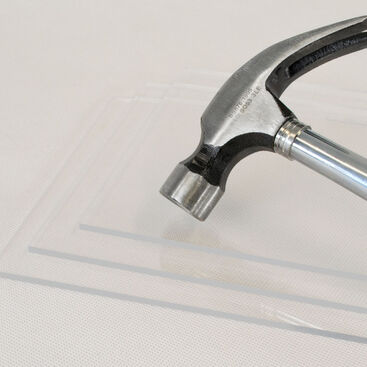Understanding Scratch Resistant Acrylic & Polycarbonate: A Comprehensive Guide
Acrylic and Polycarbonate are two materials that are hugely popular alternatives for glass. They can be used in many applications due to their diverse features and varied characteristics. Scratch-resistant acrylic/polycarbonate is a great alternative to standard materials when you are using it in areas where you want to avoid scratches and need to maintain appearance.

What does Scratch Resistant mean?
Scratch resistance denotes a material’s capability to withstand or fend off damages, like scratches, when exposed to external forces or friction. While not entirely scratch-proof, scratch-resistant materials are designed to resist scratches better than their standard counterparts. This property is highly valued across various industries as it enhances both the aesthetic and functional longevity of products, from eyeglasses and electronic screens to construction materials. Over time, technological advancements have further refined the methods to augment scratch resistance, incorporating advanced coatings and innovative manufacturing processes.
How does scratch resistant work on Acrylic/Polycarbonate?
Understanding the Basics:
At their core, both acrylic and polycarbonate are types of plastic materials known for their clarity and versatility. However, despite their transparent appearance, both materials possess a molecular structure that can be engineered for enhanced durability.
Molecular Bonds and Scratch Resistance:
The resistance to scratching in these materials largely depends on their molecular bonds. Stronger bonds between polymer chains result in a more resilient surface. When force is applied (like a scratch), these strong bonds prevent or reduce the visibility of any damage. Innovations in manufacturing have allowed the strengthening of these bonds, leading to the enhanced scratch resistance we see in modern materials.
Coating Technology:
Another significant aspect of scratch resistance is the application of clear protective coatings. These coatings, often composed of silica or other hard materials, provide an additional barrier against scratches. The layer isn’t just a surface application; it chemically bonds with the acrylic or polycarbonate, ensuring a long-lasting protective shield. Specifically, we offer a Clear Scratch Resistant Polycarbonate Sheet and Clear Scratch Resistant Perspex® Acrylic Sheet for that added extra layer of protection.
Nano-technology in Scratch Resistance:
Recent advancements in nanotechnology have introduced the use of nanoparticles in these coatings. These tiny particles imbue the surface with a roughness at the microscopic level, making it harder for larger, more noticeable scratches to form. This means that even when the material does get scratched, these marks are often microscopic and hardly visible to the naked eye.
Balancing Transparency and Durability:
A significant challenge in enhancing scratch resistance is ensuring that the material retains its clarity. Fortunately, the protective coatings and enhanced molecular bonding do not compromise the transparency of acrylic or polycarbonate. In fact, many of the latest technologies in scratch resistance aim to enhance clarity while ensuring that the material is more resilient to everyday wear and tear.
Environmental Impact:
It’s also worth noting that as technology has improved, there’s been a conscientious effort to ensure that the methods used to enhance scratch resistance are environmentally friendly. By reducing the reliance on potentially harmful chemicals and focusing on sustainable production methods, manufacturers are ensuring that these materials are not only durable but also eco-friendly.
How should I clean the acrylic/polycarbonate sheet?
The sheets should be cleaned in the same way as standard acrylic and polycarbonate sheets – with soapy water only. Check out our blog on how to clean your acrylic panels for more details on retaining a flawless look.
When to use scratch resistant material?
This type of material is best used when the application is in harsher environments or in places where damages are more likely to occur. Some common applications can include:
- Tabletop protectors
- Picture frames
- Protecting displays in schools and colleges
- Secondary glazing
- Covid protection screens
- Wall panneling
- Boat Windows
How does Standard Acrylic compare to Scratch Resistant Acrylic?
Take a look at our video where we put both acrylics to the test!
Get in touch!
Our sheets can be cut to any size and shape. If you are in need of multiple sheets, increase the quantity on the product pages to receive a volume discount. If you have any questions that haven’t been answered here – please contact the sales team and we will be happy to help!


